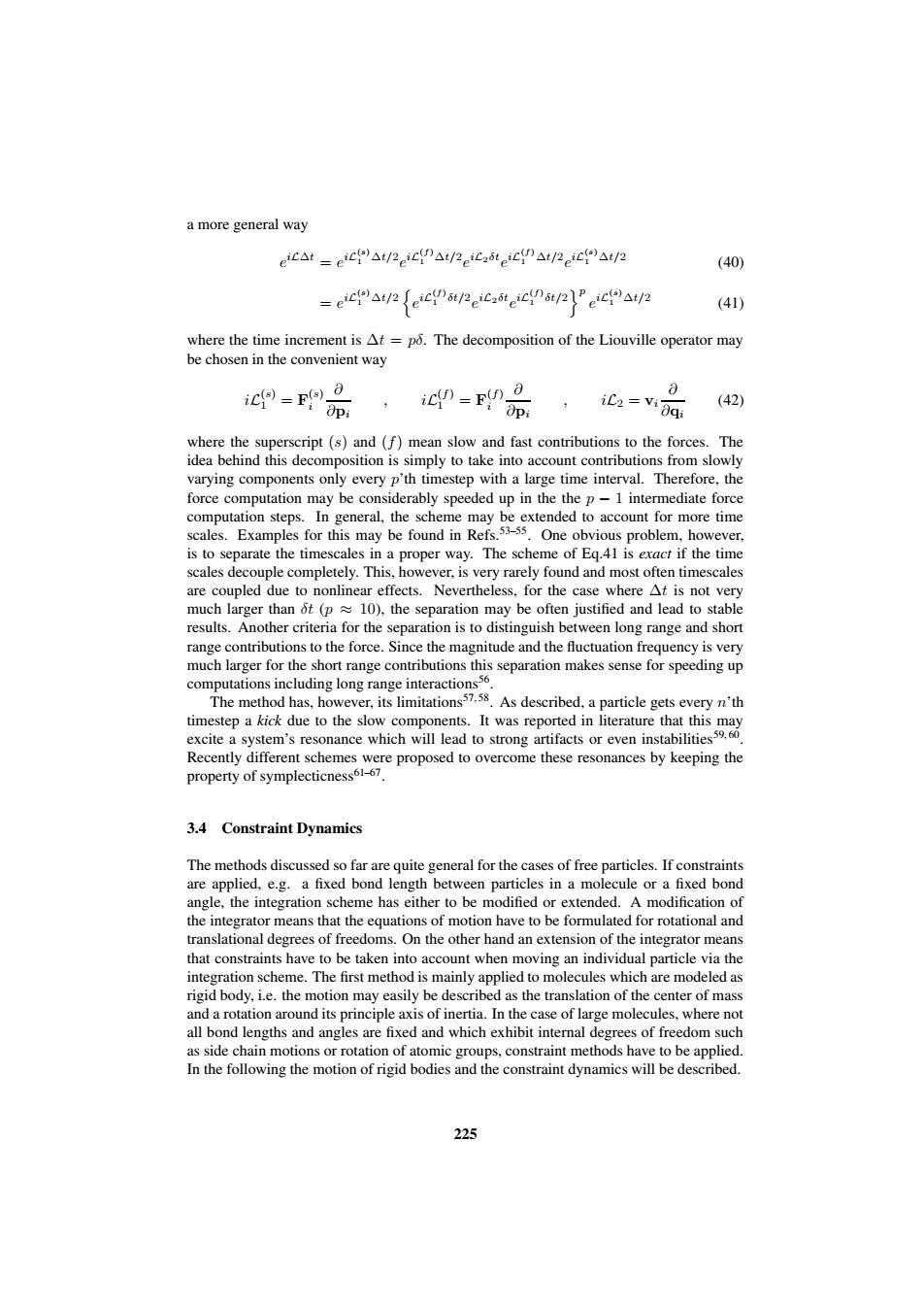正在加载图片...

a more general way ec△t=ec0△t/2eic△t/2 eicatic△t/2eice△t/2 (40) =eict eicstpeicateicspec (41) where the time increment is At =po.The decomposition of the Liouville operator may be chosen in the convenient way ic0-E()0 icfn)=B()o i0加i iL2 viaqi (42) iOpi where the superscript (s)and (f)mean slow and fast contributions to the forces.The idea behind this decomposition is simply to take into account contributions from slowly varying components only every p'th timestep with a large time interval.Therefore,the force computation may be considerably speeded up in the the p-1 intermediate force computation steps.In general,the scheme may be extended to account for more time scales.Examples for this may be found in Refs.53-55.One obvious problem,however. is to separate the timescales in a proper way.The scheme of Eq.41 is exact if the time scales decouple completely.This,however,is very rarely found and most often timescales are coupled due to nonlinear effects.Nevertheless,for the case where At is not very much larger than ot (p 10),the separation may be often justified and lead to stable results.Another criteria for the separation is to distinguish between long range and short range contributions to the force.Since the magnitude and the fluctuation frequency is very much larger for the short range contributions this separation makes sense for speeding up computations including long range interactions56 The method has,however,its limitations57.58.As described,a particle gets every n'th timestep a kick due to the slow components.It was reported in literature that this may excite a system's resonance which will lead to strong artifacts or even instabilitiess9.60 Recently different schemes were proposed to overcome these resonances by keeping the property of symplecticness61-67 3.4 Constraint Dynamics The methods discussed so far are quite general for the cases of free particles.If constraints are applied,e.g.a fixed bond length between particles in a molecule or a fixed bond angle,the integration scheme has either to be modified or extended.A modification of the integrator means that the equations of motion have to be formulated for rotational and translational degrees of freedoms.On the other hand an extension of the integrator means that constraints have to be taken into account when moving an individual particle via the integration scheme.The first method is mainly applied to molecules which are modeled as rigid body,i.e.the motion may easily be described as the translation of the center of mass and a rotation around its principle axis of inertia.In the case of large molecules,where not all bond lengths and angles are fixed and which exhibit internal degrees of freedom such as side chain motions or rotation of atomic groups,constraint methods have to be applied. In the following the motion of rigid bodies and the constraint dynamics will be described. 225a more general way e iL∆t = e iL (s) 1 ∆t/2 e iL (f) 1 ∆t/2 e iL2δt e iL (f) 1 ∆t/2 e iL (s) 1 ∆t/2 (40) = e iL (s) 1 ∆t/2 n e iL (f) 1 δt/2 e iL2δt e iL (f) 1 δt/2 op e iL (s) 1 ∆t/2 (41) where the time increment is ∆t = pδ. The decomposition of the Liouville operator may be chosen in the convenient way iL (s) 1 = F (s) i ∂ ∂pi , iL (f) 1 = F (f) i ∂ ∂pi , iL2 = vi ∂ ∂qi (42) where the superscript (s) and (f) mean slow and fast contributions to the forces. The idea behind this decomposition is simply to take into account contributions from slowly varying components only every p’th timestep with a large time interval. Therefore, the force computation may be considerably speeded up in the the p − 1 intermediate force computation steps. In general, the scheme may be extended to account for more time scales. Examples for this may be found in Refs.53–55 . One obvious problem, however, is to separate the timescales in a proper way. The scheme of Eq.41 is exact if the time scales decouple completely. This, however, is very rarely found and most often timescales are coupled due to nonlinear effects. Nevertheless, for the case where ∆t is not very much larger than δt (p ≈ 10), the separation may be often justified and lead to stable results. Another criteria for the separation is to distinguish between long range and short range contributions to the force. Since the magnitude and the fluctuation frequency is very much larger for the short range contributions this separation makes sense for speeding up computations including long range interactions56 . The method has, however, its limitations57, 58 . As described, a particle gets every n’th timestep a kick due to the slow components. It was reported in literature that this may excite a system’s resonance which will lead to strong artifacts or even instabilities59, 60 . Recently different schemes were proposed to overcome these resonances by keeping the property of symplecticness61–67 . 3.4 Constraint Dynamics The methods discussed so far are quite general for the cases of free particles. If constraints are applied, e.g. a fixed bond length between particles in a molecule or a fixed bond angle, the integration scheme has either to be modified or extended. A modification of the integrator means that the equations of motion have to be formulated for rotational and translational degrees of freedoms. On the other hand an extension of the integrator means that constraints have to be taken into account when moving an individual particle via the integration scheme. The first method is mainly applied to molecules which are modeled as rigid body, i.e. the motion may easily be described as the translation of the center of mass and a rotation around its principle axis of inertia. In the case of large molecules, where not all bond lengths and angles are fixed and which exhibit internal degrees of freedom such as side chain motions or rotation of atomic groups, constraint methods have to be applied. In the following the motion of rigid bodies and the constraint dynamics will be described. 225